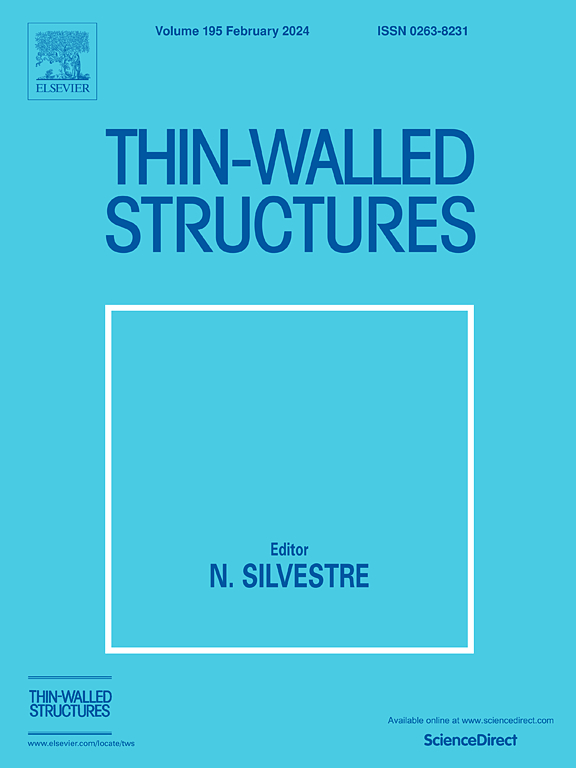采用单搭接单螺栓连接的耐高温聚酰胺复合材料的测试与模拟
IF 5.7
1区 工程技术
Q1 ENGINEERING, CIVIL
引用次数: 0
摘要
新一代航空航天飞行器的发展为确保极端环境下飞行器部件的结构完整性提出了新的要求和挑战。因此,使用耐高温聚酰胺复合材料已成为制造在高温(250 °C)下工作的航空航天飞行器部件的关键。作为这些材料的关键连接技术,螺栓连接结构在高温下的机械性能需要进一步研究。本文采用实验和数值模拟相结合的方法,研究了 T700/BMP316 复合材料螺栓连接在室温和 250 ℃ 下的承载能力和失效机理。实验结果表明,该结构在 250 °C 时的极限承载能力仅比室温环境下低 13.1%,表明此类复合材料的温度软化效应并不显著。扫描电子显微镜(SEM)和计算机断层扫描(CT)结果表明,结构的破坏模式是螺栓挤压造成的孔边纤维和基体挤压,以及层间分层破坏。复合材料主体结构考虑了温度效应,并结合使用了 Pinho 准则和 Cohesive 模型进行了有限元建模。通过数值模拟,可以准确预测整个损伤演变阶段的载荷-位移响应和损伤模式。本研究中涉及的高温试验结果和开发的有限元模型可为新一代航空航天飞行器的设计提供支持。本文章由计算机程序翻译,如有差异,请以英文原文为准。
Test and simulation of high temperature resistant polyamide composite with single lap single bolt connection
The advancement of next-generation aerospace vehicles has presented new requirements and challenges for ensuring the structural integrity of aircraft components in extreme environments. Consequently, the utilization of high temperature resistant polyamide composite materials has become pivotal in the manufacturing of aerospace vehicle parts that operate under high temperatures (250 °C). As a critical connection technology for these materials, the mechanical behavior of bolted connection structures under high temperatures requires further investigation. In this paper, a combination of experimental and numerical simulation is used to investigate the load carrying capacity and failure mechanism of T700/BMP316 composite bolted joints at room temperature and 250 °C. The experimental results show that the ultimate load carrying capacity of the structure at 250 °C is only 13.1 % lower than that of the room temperature environment, indicating that the temperature softening effect of such composites is not significant. Scanning electron microscope (SEM) and computed tomography (CT) results indicate that the structural damage modes were the crushing of the hole edge fibers and matrix due to the extrusion by the bolts, as well as the interlaminar delamination damage. Temperature effects were taken into account for the composite principal structure and finite element modeling was performed using a combination of Pinho criterion and Cohesive model. Numerical simulations allow accurate prediction of the load-displacement response and damage pattern throughout the damage evolution phase. The high temperature test results and the developed finite element model involved in this study can support the design of new-generation aerospace vehicles.
求助全文
通过发布文献求助,成功后即可免费获取论文全文。
去求助
来源期刊

Thin-Walled Structures
工程技术-工程:土木
CiteScore
9.60
自引率
20.30%
发文量
801
审稿时长
66 days
期刊介绍:
Thin-walled structures comprises an important and growing proportion of engineering construction with areas of application becoming increasingly diverse, ranging from aircraft, bridges, ships and oil rigs to storage vessels, industrial buildings and warehouses.
Many factors, including cost and weight economy, new materials and processes and the growth of powerful methods of analysis have contributed to this growth, and led to the need for a journal which concentrates specifically on structures in which problems arise due to the thinness of the walls. This field includes cold– formed sections, plate and shell structures, reinforced plastics structures and aluminium structures, and is of importance in many branches of engineering.
The primary criterion for consideration of papers in Thin–Walled Structures is that they must be concerned with thin–walled structures or the basic problems inherent in thin–walled structures. Provided this criterion is satisfied no restriction is placed on the type of construction, material or field of application. Papers on theory, experiment, design, etc., are published and it is expected that many papers will contain aspects of all three.
 求助内容:
求助内容: 应助结果提醒方式:
应助结果提醒方式:


